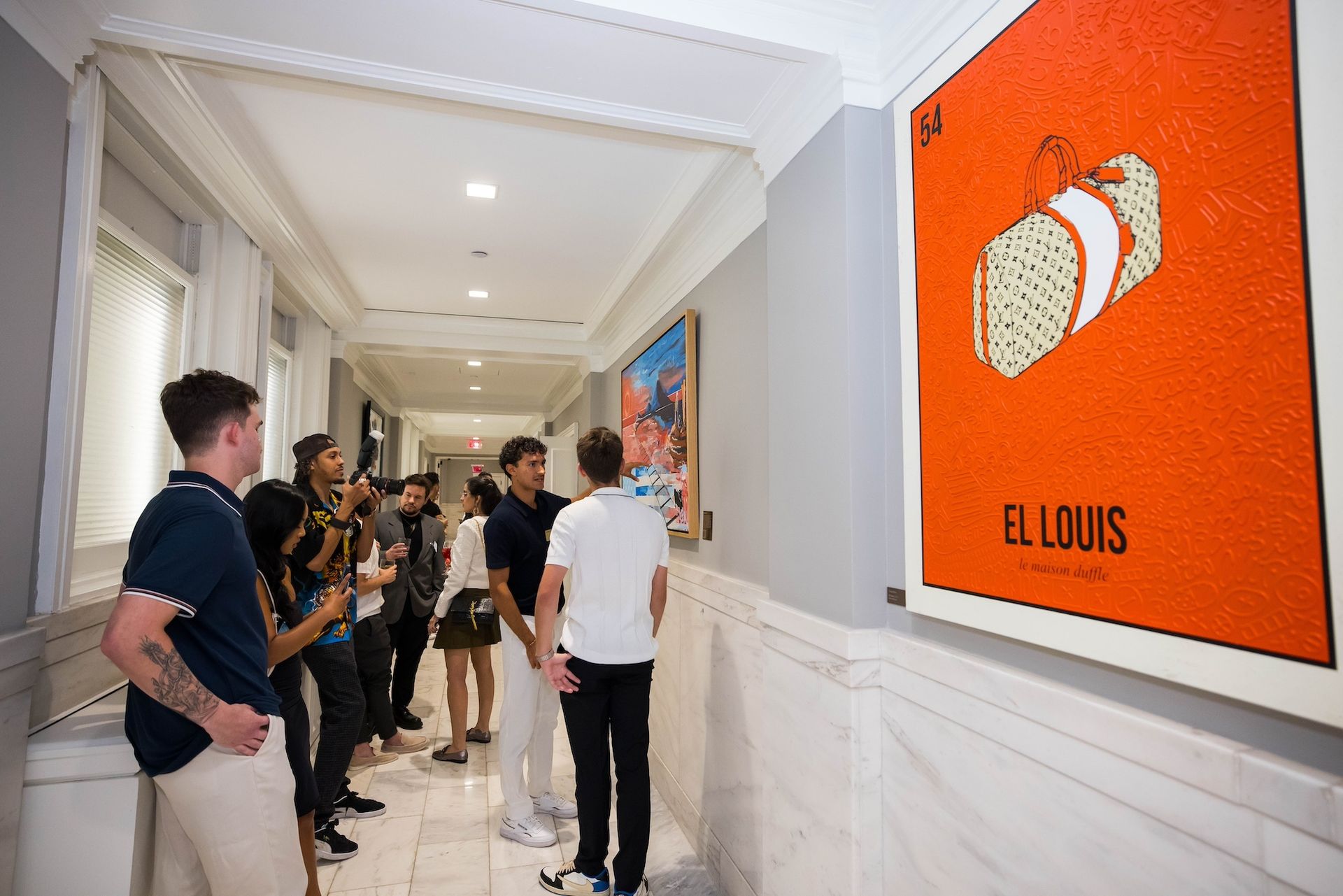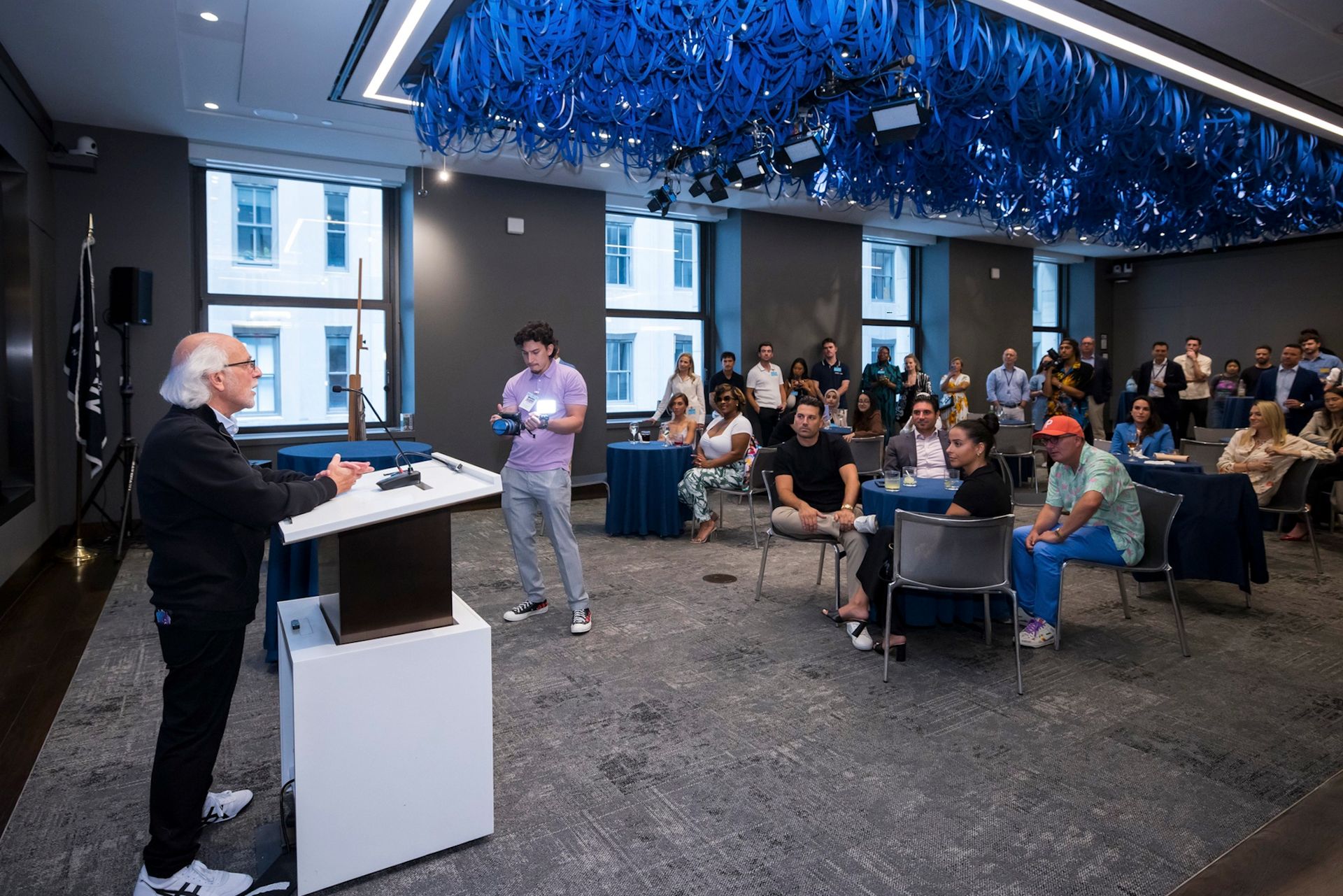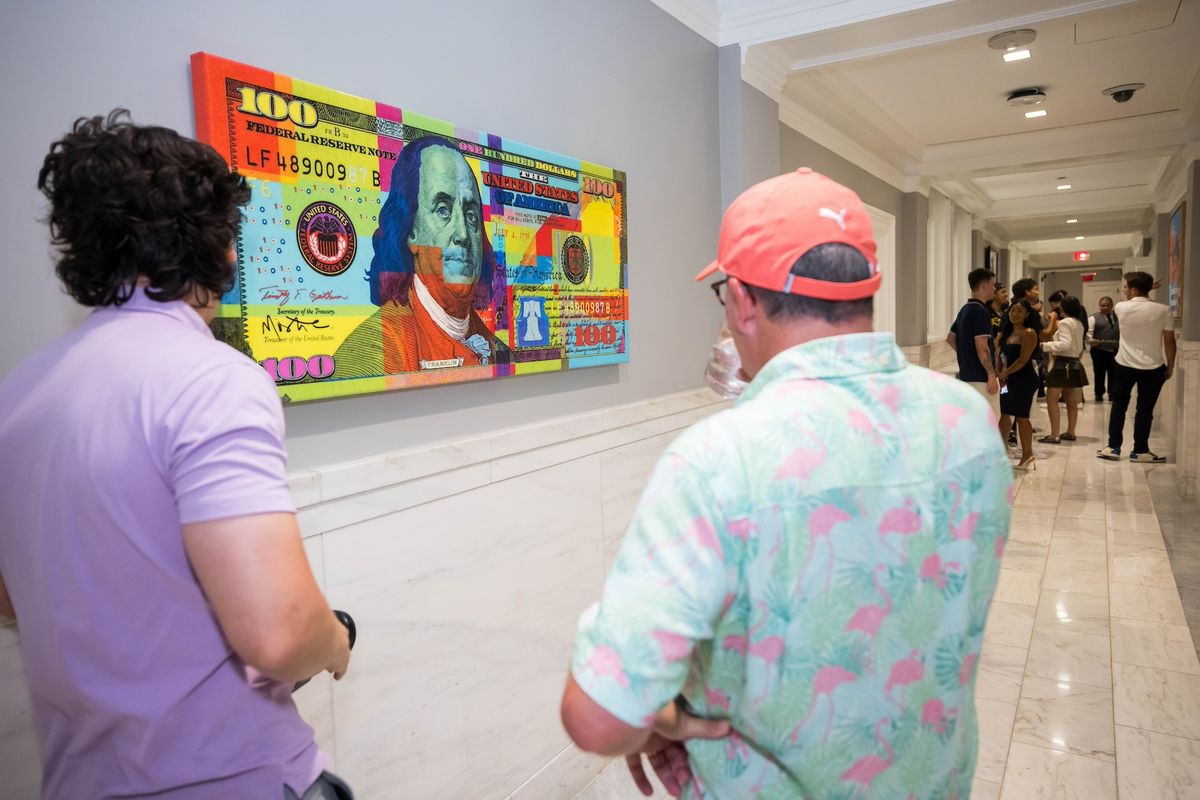In a city filled with exclusive clubs, New York City has an art gallery filled with fun, irreverent works that you cannot enter. In fact, you are not permitted to enter the entire building in which this gallery is located unless you are a registered securities trader for the New York Stock Exchange in Lower Manhattan. (Since the terror attacks of 11 September 2001, public access to the centre of world capitalism has been severely restricted.)
If you were allowed to enter the stock exchange building, however, pay a visit to the sixth floor. That is where you will find the Big Board Art Hall gallery, filled with large-scale paintings, prints and sculptures, most of them by street artists—including Mister E, King Saladeen, Hijack, WhisBe and Seek One—that in one way or another reference money. It is a fitting place for this art to be seen and for some of the titans of capitalism to see art that speaks to their occupations.

Visitors to the Big Board Art Hall gallery Photo Credit: NYSE / NYSE Art Show
The Big Board Art Hall gallery is the brainchild of Wall Street trader Peter Tuchman, who began his career in securities in 1985. He runs the space all by himself when he isn’t advising clients, giving interviews or delivering motivational speeches.
“The idea came to me,” he says, “why don't I suggest to the stock exchange that we put up some more modern art in the building, because the building is full of old etchings, old Wall Street things that are sort of archaic. I did not really think they would go for the idea, but in fact they did. They loved the idea. And so not only did they give me one wall to put up art, they gave me a whole corridor on the sixth floor of this building, which is obviously the greatest financial institution in the world.”

Visitors at a Big Board Art Hall gallery event in July 2024 Photo Credit: NYSE / NYSE Art Show
Tuchman says he came to appreciate and collect art because he grew up in a home where art and culture were honoured. His parents, Marcel and Shoshana, were Eastern European Jews who emigrated to the US in 1949, bringing with them “a certain aesthetic”, he says. “We had books and art and culture. My home growing up was always filled with beautiful art and photographs.” But it was social media, particularly Instagram images and videos of street art, that since 2017 has driven much of Tuchman’s personal collecting and provided the motivation for his art gallery.
A recurring theme in some of these works was money, which intrigued him. “It turns out that there’s a lot of it going on, people who work with the $100 bill or any number of things relating to business,” Tuchman says. “And so, I slowly created this community, inviting them down to the floor of the stock exchange and becoming friendly with them.”
The street art on display in the Big Board Art Hall is not critique, not a slap in the face of capitalism, quite the opposite. “Money certainly doesn't equal happiness, but it can equal freedom,” Mister E says. Still, it can appear jarringly out of place in the New York Stock Exchange’s august, marble-clad surroundings.

Visitors at a Big Board Art Hall gallery event in July 2024 Photo Credit: NYSE / NYSE Art Show
The sixth floor of the stock exchange, Tuchman notes, “is where the boardroom is. The boardroom dates back to 1903. The ceiling is all gorgeous Tiffany Glass. The walls are all gold flake. There's a one-of-a-kind Fabergé urn in the room. So it’s a powerful room. It's the room where CEOs are launching new companies, heads of state, presidents, prime ministers from all over the world come and are honoured at the stock exchange every morning and every afternoon.”
The Big Board Art Hall is not a commercial gallery, but sales do take place there. King Saladeen (the street art name of Raheem Saladeen Johnson) says “three of my works sold off the wall” in 2017, the year of the gallery’s debut. The buyers were a chief executive and an Australian stock trader. His works are acrylic paintings, often on canvas but sometimes on sneakers, toys and the sides of expensive automobiles. In fact, King Saladeen met Tuchman at a supercar rally. “He said to me, ‘I wish I could display your work at the New York Stock Exchange,’ and I said, ‘Bro, that would be so crazy!’”
Tuchman is not King Saladeen’s only high-end promoter and buyer—“I do a lot of corporate work,” the artist says—but the opportunity to have his work displayed in the New York Stock Exchange was a dream come true. “Those are people I never get to see,” he says. “These people have a nice amount of money.”

The artist Mister E (left) and Wall Street trader Peter Tuchman (right) during a Big Board Art Hall gallery event in July 2024 Photo Credit: NYSE / NYSE Art Show
Sales may or may not take place, but Tuchman says the art is there primarily for “people who walked down on their way to the boardroom and people who were here to ring the opening bell. It has become a place where people go and feel the wonderful peace that art has on the psyche.”
The stock market and the art market have some features in common but also are quite different in important ways, Tuckman says. “The art market is the last unregulated market,” he says, while the securities industry is highly regulated by state and federal agencies. Still, the financial investment field has seen a growth in equities, crypto markets and gold trading, among other categories. “People are always looking for alternative investments,” he adds, and art and securities “go hand in hand in so many ways for being very different and for being the same”.

Peter Tuchman speaks to artists and their guests during a Big Board Art Hall gallery event in July 2024 Photo Credit: NYSE / NYSE Art Show
Tuchman has a certain celebrity reputation within his field, mugging for the cameras and getting his pictures and comments in newspapers and magazines on a regular basis—CNN called him the “most photographed man on Wall Street”. He has described himself as the “Einstein of Wall Street”, based on his shock of white hair and assertions of his brilliance as a trader. When he contracted Covid-19 in 2020, somehow it made the news.
On view currently in the gallery is a work by Mister E, as well as some pieces by “a couple of new, young artists who are very young”, including KAWS, Cayla Birk, Daniel Cohen, Daniel Cortez, Ike Wyntera, Evan Sharma and the 16-year-old artist Henry Reed. Tuchman says they “are now getting a lot of cred”.


